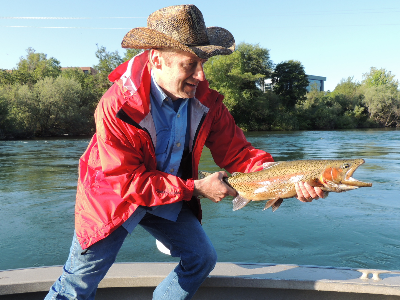Big River Rainbows in Downtown Redding
By Gary Lewis
 Dave Jacobs fired up the Mercury and Hank Mautz shoved the boat away from the dock. With the big motor at idle we let the current push us downstream toward the Sundial Bridge. It was early, but already the cowboys were stirring for the rodeo that would take place later in the day.
Dave Jacobs fired up the Mercury and Hank Mautz shoved the boat away from the dock. With the big motor at idle we let the current push us downstream toward the Sundial Bridge. It was early, but already the cowboys were stirring for the rodeo that would take place later in the day. With all the activity on the parks and in the streets, we hoped to rope some rainbows early without a lot of competition on the water.
A lot of anglers roll through Redding on their way to chase salmon and steelhead in the north or striped bass in the south, but there is a good reason to stop. Sam Pyke and I stayed at the Best Western Hilltop on a Friday night then rolled out of our beds at 4:30 in the morning to stumble down the stairs with fishing rods and cameras.
This is good trout water in the tail water below the Shasta and Keswick dams. I first fished with Dave and Hank several years ago on a day the trout averaged 16 to 17 inches. Dave said the fish were bigger now.
Some people are just plain fishy. That would describe Dave Jacobs and Hank Mautz. Dave has guided in northern California for the last nine years. Hank, a retired guide, is his mentor. With this much fishing mojo, we couldn't help but have a good day.
Dave handed me a rod rigged with pencil lead and a barbless Glo-Bug on a 30-inch leader. Hank offered me a tray of tiny steelhead egg baits cured in Pautzke's Borax O'Fire mix. I secured the eggs beneath the egg loop and waited to make my first cast.
Downstream from the Sundial, we let our baits bounce through the shallow water as Dave watched our rod tips and kept our lines tight with the kicker motor.
Bounce, bounce, bounce. After a few bumps on the bottom the rod loaded with an energy transmitted through the graphite. I lifted the tip and a trout peeled away off the gravel bar and out into the main channel. When the fish was near the boat, Hank slipped the net beneath the 18-inch wild rainbow.
Downstream, we worked bank to bank, bouncing our baits through the current seams.
Where the river widened, Jacobs and Mautz pointed toward the site of the old concrete plant. Here the builders of the Shasta Dam grabbed the gravel that was used in the construction project. We saw the old concrete footings that supported a huge conveyor belt that moved the material up to the dam site.
 There was a time when this section of river and its banks were poisoned by copper mining. There was a time when tons and tons of gravel were harvested from the river bed. But now the wild trout find a home in the cool water beneath the dam, right in the heart of this California city.
There was a time when this section of river and its banks were poisoned by copper mining. There was a time when tons and tons of gravel were harvested from the river bed. But now the wild trout find a home in the cool water beneath the dam, right in the heart of this California city. When Hank hooked his first fish, a trout of about 16 inches, he told me to keep my Glo-Bug in the water. Seconds later, I was tied to another rainbow. That was the first of three doubles. On the second double, we brought the fish close enough together that when Dave plunged for them with the net, he brought up both fish in a single scoop.
Beneath the Highway 44 bridge, we tried for a triple, but Dave's trout threw the hook.
There is a knack to drift fishing. The fish drops back as the Glo-Bug approaches, then it commits, opens its mouth and expels water out of its gills. When the fish feels the hook, it tries to shake the bait out of its mouth. If we sense the bite at all, often that head-shake is our first clue we got a bite.
Hank Mautz, who was one of the pioneers of this technique we call side-drifting, showed me how he uses his trigger finger to get a better sense of the bite. Instead of placing his finger on the rod, he indexes the line right off the spool, his index finger ready to sense the pulse of that first mouthing of the bait.
Past stocking efforts get the credit for this tailwater fishery, but there wasn't a single fish we landed that was raised in a hatchery. These were wild, well-fed rainbows, brilliant in color, each a rare jewel unto itself. Some were covered with spots, while others showed a cutthroat influence. A few were flecked with gold and copper. The biggest of the day was a hook-jawed male I guessed at about five pounds.
At the end of the morning, we walked through the abandoned concrete plant in the park at Turtle Bay. East of Redding, we sashayed the streets of Old Shasta, where we found examples of the art and a few of the guns of old California on display in what was the old courthouse and jail. A glimpse back in time.
As we headed south on the interstate, I threw one last look back at the Sacramento. There are wilder places to catch wild rainbow, but to me, this big river ranks among the West's best places to catch great trout in the heart of a city.


